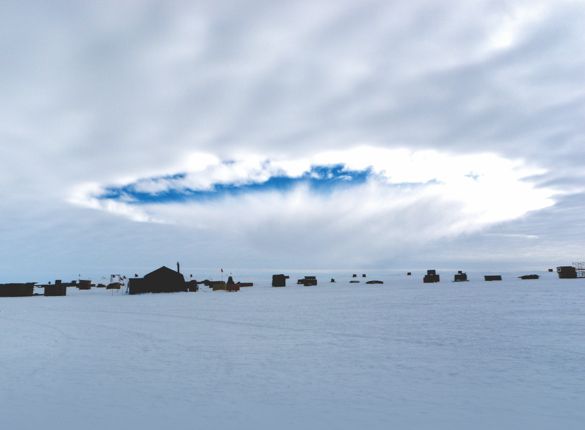Punching holes in clouds
DOI: 10.1063/PT.3.1229
Airplanes flying sufficiently high overhead, where the temperature is −40 °C or colder, will leave familiar condensation trails, or contrails, as water vapor expelled in the plane’s exhaust forms droplets or ice particles. But that is not the only effect that planes leave in their wake. Planes passing through midlevel clouds can induce linear voids, known as canal clouds, and circular voids, called hole-punch clouds or fallstreak holes. Seen here is a hole-punch cloud over the West Antarctic ice sheet in December 2009. Gray streams of ice—the fallstreaks—are visible below the hole, which formed near the horizon and moved toward the camera. The hole was likely caused by a Lockheed LC-130 four-engine turboprop.
Hole-punch and canal clouds have been associated with aircraft since the late 1940s. Now Andrew Heymsfield of the National Center for Atmospheric Research and colleagues have combined observational data and computer simulations to gain new insight into their formation and evolution. The holes form in clouds containing droplets of subfreezing, supercooled liquid water. As air passes over jet wings or around propeller tips, it expands and cools by 20–30 °C, and where the cooled air reaches −40 °C the water droplets will freeze spontaneously. The ice crystals grow rapidly as they trigger droplet evaporation and subsequent vapor deposition. When sufficiently big, the crystals will fall out of the cloud—the essence of cloud seeding.
But that doesn’t explain how holes can grow to be wider than 100 km and last for more than an hour. The simulations confirmed the importance of vertical motion: As the ice crystals form, they release latent heat that triggers updrafts; at the hole’s periphery, droplets in compensating downdrafts warm and evaporate, which rapidly widens the hole, until the process peters out after about 90 minutes. Applying their results to real-world scenarios, the researchers find that inadvertent cloud seeding by aircraft could, on average, occur near major airports up to 6% of the time—and more often in winter months—increasing the precipitation in the surrounding areas. (
To submit candidate images for Back Scatter, visit http://www.physicstoday.org/about_us/submit_content

Photo by Eric Zrubek and Michael Carmody

